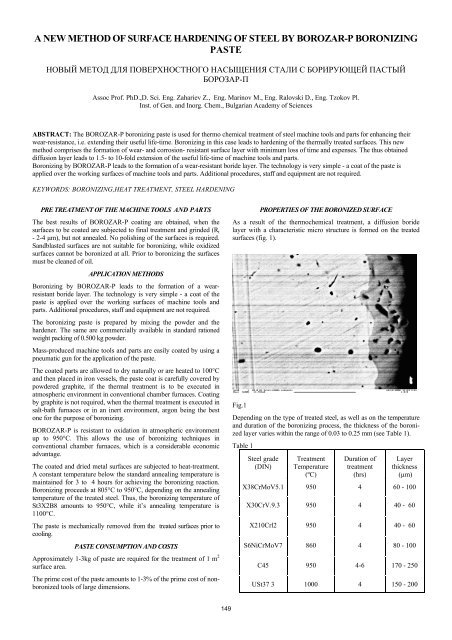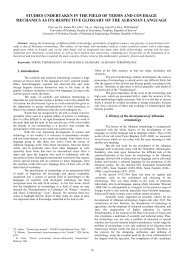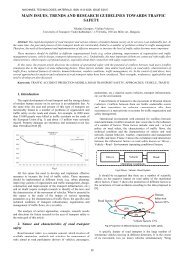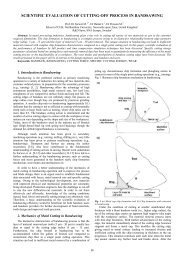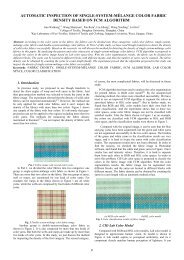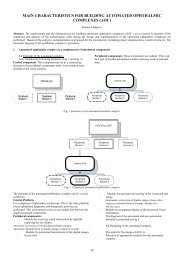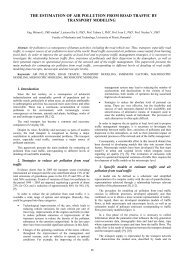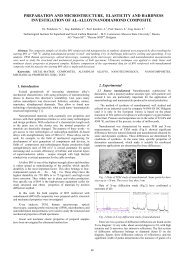a new method of surface hardening of steel by borozar-p boronizing
a new method of surface hardening of steel by borozar-p boronizing
a new method of surface hardening of steel by borozar-p boronizing
You also want an ePaper? Increase the reach of your titles
YUMPU automatically turns print PDFs into web optimized ePapers that Google loves.
A NEW METHOD OF SURFACE HARDENING OF STEEL BY BOROZAR-P BORONIZING<br />
PASTE<br />
НОВЫЙ МЕТОД ДЛЯ ПОВЕРХНОСТНОГО НАСЫЩЕНИЯ СТАЛИ С БОРИРУЮЩЕЙ ПАСТЫЙ<br />
БОРОЗАР-П<br />
Assoc Pr<strong>of</strong>. PhD.,D. Sci. Eng. Zahariev Z., Eng. Marinov M., Eng. Ralovski D., Eng. Tzokov Pl.<br />
Inst. <strong>of</strong> Gen. and Inorg. Chem., Bulgarian Academy <strong>of</strong> Sciences<br />
ABSTRACT: The BOROZAR-P <strong>boronizing</strong> paste is used for thermo chemical treatment <strong>of</strong> <strong>steel</strong> machine tools and parts for enhancing their<br />
wear-resistance, i.e. extending their useful life-time. Boronizing in this case leads to <strong>hardening</strong> <strong>of</strong> the thermally treated <strong>surface</strong>s. This <strong>new</strong><br />
<strong>method</strong> comprises the formation <strong>of</strong> wear- and corrosion- resistant <strong>surface</strong> layer with minimum loss <strong>of</strong> time and expenses. The thus obtained<br />
diffusion layer leads to 1.5- to 10-fold extension <strong>of</strong> the useful life-time <strong>of</strong> machine tools and parts.<br />
Boronizing <strong>by</strong> BOROZAR-P leads to the formation <strong>of</strong> a wear-resistant boride layer. The technology is very simple - a coat <strong>of</strong> the paste is<br />
applied over the working <strong>surface</strong>s <strong>of</strong> machine tools and parts. Additional procedures, staff and equipment are not required.<br />
KEYWORDS: BORONIZING,HEAT TREATMENT, STEEL HARDENING<br />
PRE TREATMENT OF THE MACHINE TOOLS AND PARTS<br />
The best results <strong>of</strong> BOROZAR-P coating are obtained, when the<br />
<strong>surface</strong>s to be coated are subjected to final treatment and grinded (R t<br />
- 2-4 μm), but not annealed. No polishing <strong>of</strong> the <strong>surface</strong>s is required.<br />
Sandblasted <strong>surface</strong>s are not suitable for <strong>boronizing</strong>, while oxidized<br />
<strong>surface</strong>s cannot be boronized at all. Prior to <strong>boronizing</strong> the <strong>surface</strong>s<br />
must be cleaned <strong>of</strong> oil.<br />
APPLICATION METHODS<br />
Boronizing <strong>by</strong> BOROZAR-P leads to the formation <strong>of</strong> a wearresistant<br />
boride layer. The technology is very simple - a coat <strong>of</strong> the<br />
paste is applied over the working <strong>surface</strong>s <strong>of</strong> machine tools and<br />
parts. Additional procedures, staff and equipment are not required.<br />
The <strong>boronizing</strong> paste is prepared <strong>by</strong> mixing the powder and the<br />
hardener. The same are commercially available in standard rationed<br />
weight packing <strong>of</strong> 0.500 kg powder.<br />
Mass-produced machine tools and parts are easily coated <strong>by</strong> using a<br />
pneumatic gun for the application <strong>of</strong> the paste.<br />
The coated parts are allowed to dry naturally or are heated to 100°C<br />
and then placed in iron vessels, the paste coat is carefully covered <strong>by</strong><br />
powdered graphite, if the thermal treatment is to be executed in<br />
atmospheric environment in conventional chamber furnaces. Coating<br />
<strong>by</strong> graphite is not required, when the thermal treatment is executed in<br />
salt-bath furnaces or in an inert environment, argon being the best<br />
one for the purpose <strong>of</strong> <strong>boronizing</strong>.<br />
BOROZAR-P is resistant to oxidation in atmospheric environment<br />
up to 950°C. This allows the use <strong>of</strong> <strong>boronizing</strong> techniques in<br />
conventional chamber furnaces, which is a considerable economic<br />
advantage.<br />
The coated and dried metal <strong>surface</strong>s are subjected to heat-treatment.<br />
A constant temperature below the standard annealing temperature is<br />
maintained for 3 to 4 hours for achieving the <strong>boronizing</strong> reaction.<br />
Boronizing proceeds at 805°C to 950°C, depending on the annealing<br />
temperature <strong>of</strong> the treated <strong>steel</strong>. Thus, the <strong>boronizing</strong> temperature <strong>of</strong><br />
St3X2B8 amounts to 950°C, while it’s annealing temperature is<br />
1100°C.<br />
The paste is mechanically removed from the treated <strong>surface</strong>s prior to<br />
cooling.<br />
PASTE CONSUMPTION AND COSTS<br />
Approximately 1-3kg <strong>of</strong> paste are required for the treatment <strong>of</strong> 1 m 2<br />
<strong>surface</strong> area.<br />
The prime cost <strong>of</strong> the paste amounts to 1-3% <strong>of</strong> the prime cost <strong>of</strong> nonboronized<br />
tools <strong>of</strong> large dimensions.<br />
149<br />
PROPERTIES OF THE BORONIZED SURFACE<br />
As a result <strong>of</strong> the thermochemical treatment, a diffusion boride<br />
layer with a characteristic micro structure is formed on the treated<br />
<strong>surface</strong>s (fig. 1).<br />
Fig.1<br />
Depending on the type <strong>of</strong> treated <strong>steel</strong>, as well as on the temperature<br />
and duration <strong>of</strong> the <strong>boronizing</strong> process, the thickness <strong>of</strong> the boronized<br />
layer varies within the range <strong>of</strong> 0.03 to 0.25 mm (see Table 1).<br />
Table 1<br />
Steel grade<br />
(DIN)<br />
Treatment<br />
Temperature<br />
(ºC)<br />
Duration <strong>of</strong><br />
treatment<br />
(hrs)<br />
Layer<br />
thickness<br />
(µm)<br />
X38CrMoV5.1 950 4 60 - 100<br />
X30CrV.9.3 950 4 40 - 60<br />
X210Crl2 950 4 40 - 60<br />
S6NiCrMoV7 860 4 80 - 100<br />
C45 950 4-6 170 - 250<br />
USt37 3 1000 4 150 - 200
The diffusion layer has a very high hardness (HV 0.1=14700-21000<br />
MPa), which is equivalent to the hardness <strong>of</strong> tungsten carbide or<br />
corundum alloys. This property <strong>of</strong> the boride layer provides for the<br />
high wear-resistance <strong>of</strong> the treated <strong>surface</strong>s.<br />
The hardness <strong>of</strong> the boride layer, i.e. its wear-resistance, significantly<br />
exceeds that, which can be obtained <strong>by</strong> conventional thermochemical<br />
treatment processes, e.g. carbonizing, nitriding, etc. (Table 2).<br />
Table 2<br />
Material HV 0,1 Material HV 0,1<br />
High-speed<br />
<strong>steel</strong><br />
En1A<br />
Cemented<br />
carbon <strong>steel</strong><br />
750 Grey cast iron<br />
(boronized)<br />
770 - 827 Carbon <strong>steel</strong><br />
(boronized)<br />
Nitrided <strong>steel</strong> 1200 En8 Steel alloy<br />
(boronized)<br />
Tungsten<br />
carbide<br />
(7% Co)<br />
1600 A.I.S.I. H13<br />
(boronized)<br />
1200 - 1400<br />
1800 - 2100<br />
1800 - 2100<br />
2000 - 2400<br />
The hardness <strong>of</strong> the boride layer is measured according to Vickers<br />
and Knoop. Testing according to Rockwell or Brinell leads to<br />
deformation <strong>of</strong> the samples' main material and destruction <strong>of</strong> the<br />
boride layer. The hardness is measured perpendicularly to the <strong>surface</strong><br />
in the case <strong>of</strong> metallographic samples or well-polished <strong>surface</strong>s.<br />
Due to the brittleness <strong>of</strong> the super-hard layer obtained, high<br />
indentation loads are to be avoided, since they may cause the<br />
formation <strong>of</strong> cracks and, as a result, to insufficiently precise test<br />
data. Due to the above, loads <strong>of</strong> 1N (HV 0.1 or HK 0.1) are to be used.<br />
Another advantage <strong>of</strong> the BOROZAR-P paste is that it increases the<br />
oxidation resistance <strong>of</strong> <strong>steel</strong> tools at 800 to 1000°C much more than<br />
conventional <strong>boronizing</strong> mixtures (Fig. 2).<br />
Fig.2<br />
150<br />
SUITABLE FOR BORONIZING MACHINE TOOLS AND PARTS<br />
The paste is suitable for treatment <strong>of</strong> <strong>steel</strong> machine tools and parts <strong>of</strong><br />
large dimensions, e.g. metal stamps, hammering press matrices,<br />
guides, rolls for wiredrawing, <strong>steel</strong> pulleys, <strong>steel</strong> belt conveyor rolls,<br />
ploughshares, tracks, extruder screws and other similar machine parts,<br />
subjected to wear and corrosion. Machine tools, instruments and<br />
parts with larger design tolerances as regards cross-section<br />
dimensions are especially suitable for <strong>boronizing</strong> <strong>by</strong> BOROZAR-P<br />
paste.<br />
In the case <strong>of</strong> elements with smaller design tolerances, e.g. dies and<br />
punches, nozzles, moulds, etc., the available <strong>boronizing</strong> agent<br />
BOROZAR-C should be used. The tools or machine parts are placed<br />
in containers and heated in atmospheric environment in chamber<br />
furnaces. Upon completion <strong>of</strong> the abovementioned process, the tools<br />
or parts are removed from the containers and are annealed.<br />
Most grades <strong>of</strong> converted and hardened, stainless <strong>steel</strong>s, as well as<br />
<strong>steel</strong> casts, armco iron, cast iron, sintered iron and <strong>steel</strong> alloys and<br />
tungsten carbide alloys, etc., are suitable for <strong>boronizing</strong>. Table 3<br />
shows the already tested for <strong>boronizing</strong> different grades <strong>of</strong> <strong>steel</strong> and<br />
alloys.<br />
Table 3<br />
Steel grade<br />
AISI BSI DIN<br />
Application examples<br />
L6 Nr.5<br />
(BS224)<br />
56NiCrMoV7 Forging dies<br />
Hll BH11 X38CrMoV5.1 Pistons, injection<br />
cylinders<br />
H10 BHIO<br />
BHIOA<br />
X32CrMoV33 Forging dies<br />
D3 BD3 X210Cr12 Press tools, dies,<br />
punches<br />
D2 - X165CrMoV12 Drawing tools, rolls<br />
for cold rolling<br />
S1 BSI 60WCrV7 Dies, punches,<br />
drawing rings<br />
L2 115CrV3 Pins<br />
C1020 C15 Pump shafts & screws<br />
C1043 C45 Pins, grinding disks<br />
420 420S45<br />
(En56D)<br />
X40Crl3 Spare parts for valves<br />
4150 708A42 50CrMo4 Screw-conveyor &<br />
extruder bushes; nonreturn<br />
valves<br />
105WCr6 Guide rings<br />
BOROZAR-TM should be used for <strong>boronizing</strong> hard-alloy tungsten-<br />
carbide drawing plates, used in manufacturing <strong>steel</strong>-wire cables,<br />
rods and wires, as well as other hard-alloy tools. The thermochemical<br />
treatment in this case is achieved in a special high-cap continuousoperation<br />
installation Bor-6СМ-З.<br />
Aluminum-alloyed <strong>steel</strong>, as well as <strong>steel</strong>, containing more than 1%<br />
silicon, is not suitable for <strong>boronizing</strong>.<br />
Another advantage <strong>of</strong> <strong>boronizing</strong> is the fact, that it allows the use <strong>of</strong><br />
low-alloy and cheaper <strong>steel</strong> for the manufacturing <strong>of</strong> parts and tools,<br />
a requirement on which is high <strong>surface</strong> hardness and high corrosion
esistance. For instance, <strong>boronizing</strong> substantially improves the acidcorrosion-resistance<br />
<strong>of</strong> plain <strong>steel</strong>. Fig. 3 illustrates the complete<br />
dissolving <strong>of</strong> the plain <strong>steel</strong> in 20% hydrochloric acid and its<br />
respective corrosion-resistance as a result <strong>of</strong> <strong>boronizing</strong>.<br />
Fig.3<br />
The boride layer has also been found to show commendable resistance<br />
in relation to sulphuric, phosphoric and organic acids (Fig. 4),<br />
as well as in relation to sodium hydroxide solutions.<br />
151<br />
Fig.4<br />
Boronized machine tools and parts, left after drying for a considerable<br />
time period in a humid air environment, become coated <strong>by</strong> a thin rust<br />
layer.<br />
The corrosion-resistance <strong>of</strong> boronized <strong>surface</strong>s, as well as their low<br />
cold-weldability and adhesion to other <strong>surface</strong>s, ensures a wide range<br />
<strong>of</strong> application <strong>of</strong> BOROZAR-P and BOROZAR-S in the chemical<br />
industry and especially in the processing <strong>of</strong> plastics, parts <strong>of</strong><br />
pneumatic conveyance devices, hammer mills, etc., as well as in<br />
foundry works.


